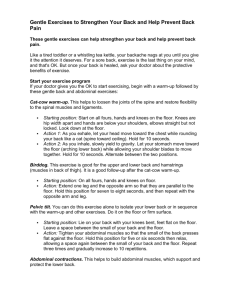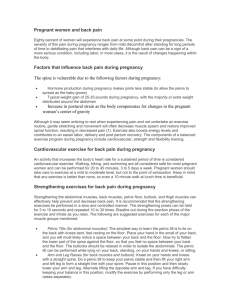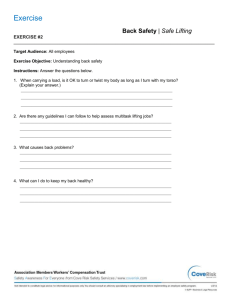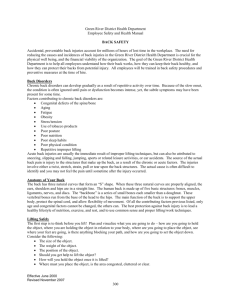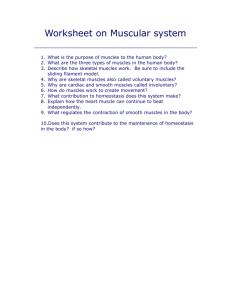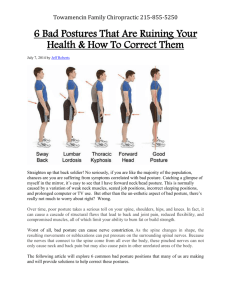Spine Center Exercises for the Neck and Back-1
advertisement
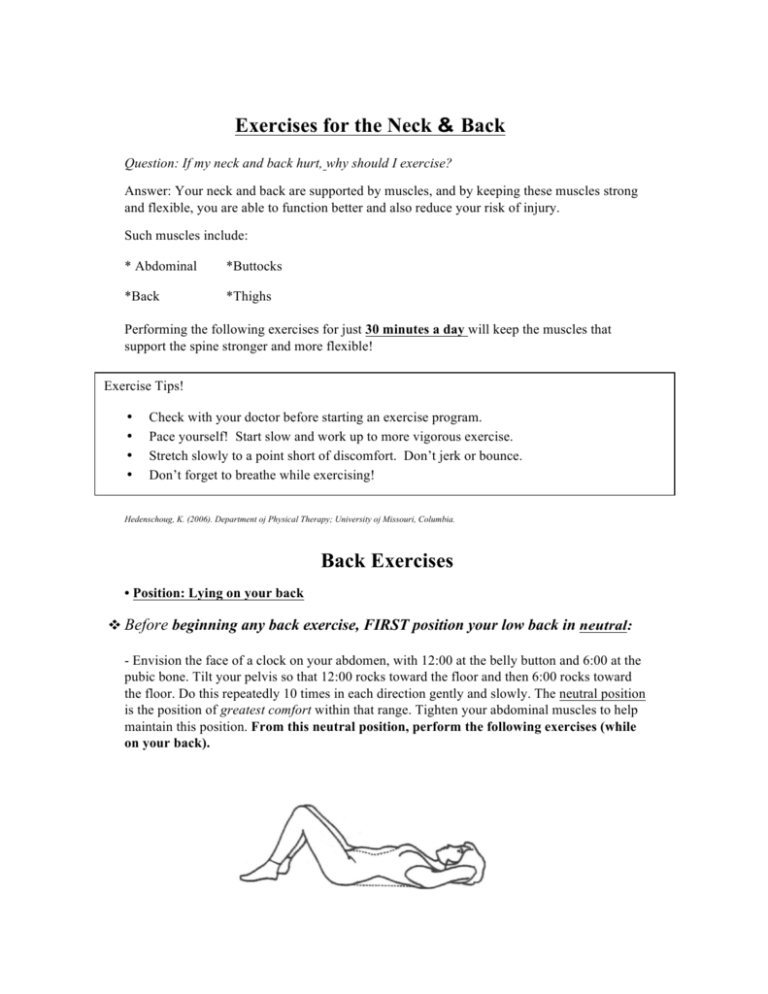
Exercises for the Neck & Back Question: If my neck and back hurt, why should I exercise? Answer: Your neck and back are supported by muscles, and by keeping these muscles strong and flexible, you are able to function better and also reduce your risk of injury. Such muscles include: * Abdominal *Buttocks *Back *Thighs Performing the following exercises for just 30 minutes a day will keep the muscles that support the spine stronger and more flexible! Exercise Tips! • • • • • Check with your doctor before starting an exercise program. Pace yourself! Start slow and work up to more vigorous exercise. Stretch slowly to a point short of discomfort. Don’t jerk or bounce. Don’t forget to breathe while exercising! Hedenschoug, K. (2006). Department oj Physical Therapy; University oj Missouri, Columbia. Back Exercises • Position: Lying on your back v Before beginning any back exercise, FIRST position your low back in neutral: - Envision the face of a clock on your abdomen, with 12:00 at the belly button and 6:00 at the pubic bone. Tilt your pelvis so that 12:00 rocks toward the floor and then 6:00 rocks toward the floor. Do this repeatedly 10 times in each direction gently and slowly. The neutral position is the position of greatest comfort within that range. Tighten your abdominal muscles to help maintain this position. From this neutral position, perform the following exercises (while on your back). 1. Bridge-Up Lie on your back with your knees bent. Keep your feet and palms flat on the floor. Slowly raise your hips upward, tightening your buttocks. Raise your hips high enough to straighten your back. Hold for 5 seconds. Lower your hips to the floor. Repeat 10 times. Copynght VH/ /999·2005 Copyright VH//999-2005 2. Partial Curl-Up Cross your arms loosely. Tighten your abdomen and curl halfway up, keeping your head in line with your shoulders. Hold for 5 seconds and then uncurl to lie down. Repeat 10 times. 3. Hamstring Stretch Put a towel behind one knee or calf. Use the towel to pull the leg toward your chest, keeping the leg straight or slightly bent. Hold for 20 seconds and then lower the leg. Repeat 3 times, and then switch legs. Copyngbt VH//999-2005 Copyright VH//999-2005 4. Trunk Rotation Drop both knees to one side and turn your head, looking in the other direction. Keep your shoulders flat on the floor. Hold for 20 seconds, then slowly switch sides. Perform 3 times on each side. Copyright VH//999-2005 • Position: Lying on your stomach 1. Press-Up Lie face down, feet slightly apart, forehead on the floor. Push yourself up on your forearms, keeping your neck straight. Stop when you feel light pressure in your lower back. Hold for 20 seconds, then slowly lie back down. Repeat 3 times. Copyright VH//999-2005 • Position: On hands and knees 1. Cat Stretch Begin by tightening you abdominal and buttocks muscles to press your back upward. Let your head drop slightly. Hold for 5 seconds. Next, slowly relax your abdominal and buttocks muscles, lifting your head and letting your back sag. Keep your weight evenly distributed. Hold for 10 seconds. Repeat 3 times. Copyright VH//999-2005 2. Arm Reach Stretch one arm straight out in front of you. Do not raise your head or let your supporting shoulder sag. To prevent your trunk from sagging, tighten your abdominal muscles! Hold for 5 seconds, then lower arm to ground. Repeat 10 times, then switch arms. Copyright VH//999-2005 3. Arm Reach with Leg Reach Extend one leg straight back while extending opposite arm straight forward. Do not arch your back or let your head or body sag. Tighten your abdominal muscles! Hold for 5 seconds, then lower knee and arm to ground. Repeat 10 times, then switch legs. Copynght VH//999-2005 4. Spine Stretch Assume the hands and knees position. Begin to sit backwards onto your heels until you feel a good, painless stretch in your buttocks. Hold for 20 seconds, then return to hands and knees position. Repeat 3 times. Copynght VH//999-2005 • Position: Standing 1. Hip Flexor Stretch Kneel on the floor. Put one foot on the floor in front of you with the knee slightly bent. If needed, hold on to a chair for balance. Tighten your abdomen. Move your hips forward, keeping your back and shoulders upright. Feel the stretch in front of your hip. Hold for 15 seconds. Return to starting position. Repeat 3 times, then switch sides. Copyright VH11999-2005 2. Quadriceps Stretch Stand arm's length from a wall. Place one hand on it. With your other hand, grasp your ankle on the same side. Pull the heel towards your buttocks, and then stand with your knees together. Do not arch your back. Hold for 15 seconds. Repeat 3 times, then switch legs. Copyright VH11999-2005 3. Calf Stretch Face a wall 2 feet away. Step toward the wall with one foot. Place both palms on the wall and bend your front knee. Lean forward, keeping the back leg straight and heel on the floor. Hold for 15 seconds. Repeat 3 times, then switch. legs. Copyright VHI J999-2005 Neck Exercises • Range-of-Motion Exercises Slowly turn your head to the right side as far as is comfortable. Hold for 10 seconds. Return your head to center. Do the same turn to the left side. Repeat 3 times on each side. Copyright VHI 1999-2005 Drop your chin down slowly toward your chest as far as is comfortable. Hold for 10 seconds. Bring your head back up. Repeat 3 times. Copyngbt VHI 1999-2005 Tilt your head to the side toward your left shoulder. Hold for 10 seconds. Return your head to center. Do the same toward the right side. Repeat 3 times on each side. Copynght VH11999-2005 (1) First, perform a chin tuck. (2) From this position, tilt your head backward so you can see the ceiling. Hold for 10 seconds, then bring your head upright. Repeat 3 times. Copynght VH11999-­‐2005 Copynght VH11999-­‐2005 • Isometric Exercises Press your forehead into your palms slowly. Resist any forward motion with your hands. Hold for 5 seconds, then relax. Repeat 10 times. Place your hand against the side of your head. Push slowly with your hand while resisting with your neck muscles. Hold for 5 seconds. Repeat 10 times. Copyright VH/ /999-2005 Copyright VH/ /999-2005 Place both hands against the back of your head. Try to push your head back, while resisting any movement with your hands. Hold for 5 seconds. Repeat 10 times. Place your hand on the side of your head. Try to turn your chin to your shoulder, but resist any motion with your hand. Hold for 5 seconds. Repeat 10 times. Copyright VH/ /999-­‐2005 Copyright VH/ /999-­‐2005 Hedenschoug, K. (2006). Department of Physical Therapy; University of Missouri, Columbia. Aerobic Conditioning Question: Why do 1 need to participate in aerobic exercise? Isn't strengthening the muscles in my neck and back enough? Answer: Aerobic exercise conditions the heart and lungs, improves circulation, tones muscles, and helps you to control your weight. All of this helps you to maintain a healthy back! •• Getting Started: • • • • • Start with a 5-10 minute walk. Add a few more minutes each day. Progress to taking three 10-minute walks each day. Walk to visit a friend instead of talking on the phone. Walk around the entire store or mall before you shop. Make it a GOAL to walk 30 minutes each day! CHOOSE AN ACTIVITY YOU ENJOY! Walking Bicycling Skiing Basketball Tennis Swimming Running Water Aerobics Volleyball Hiking • Monitor How Hard You Are Exercising! • During the aerobic activity you choose, aim for a rating of between 4 and 6 on the following scale ("somewhat severe breathlessness" to "severe breathlessness"). A rating within this range indicates that you are exercising at a proper level of intensity. •Borg Scale for Rating Perceived Shortness of Breath • 0 0.5 1 2 3 4 5 6 7 8 9 10 Nothing at all. Very, very slight Gust noticeable). Very slight. Slight. Moderate. Somewhat severe. Severe. Very severe. Very, very severe (almost maximal). Maximal. Hedenschoug. K. (2006). Department of Physical Therapy; University of Missouri, Columbia. • 5 Keys to PREVENTION of Neck & Back Injury. #1 Posture By maintaining proper posture in all positions, you can reduce the stress on your spine. This helps to prevent back injury. Check Your Standing Posture To improve your standing posture, following these steps: • • • • Breathe deeply. Relax your shoulders, hips, and knees. Think of the ears, shoulders, hips, and ankles as a series of dots. Now, adjust your body to connect the dots in a straight line. Tuck your buttocks in just a bit if you need to. #2 Rest Proper rest is vital to the maintenance and function of a healthy back. #3 Body mechanics It is important to keep your back "locked in" while performing all activities. This means that you should maintain proper posture while performing all activities. The following are examples of correct and incorrect ways of doing everyday activities. Notice the position of the spine in the correct examples. #4 Lifting Most back injuries occur while lifting! Use proper lifting techniques to prevent injury. #5 Exercise Make it your goal to maintain good mobility and strength in your back. Exercise should be a daily routine activity for the rest of your life! Hedenschoug, K. (2006). Department of Physical Therapy: University of Missouri, Columbia.
